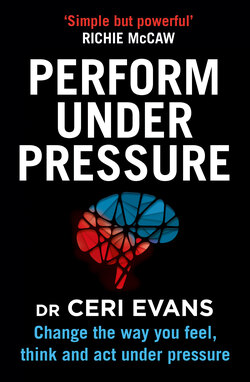Читать книгу Perform Under Pressure - Ceri Evans - Страница 18
2. Fight–flight–freeze
ОглавлениеLife would be straightforward if we were able to function in comfortable conditions all the time. But we know that in our evolutionary past, we faced deadly threats and had to be constantly on our guard. Think of it in terms of a predator and its prey: the prey either has to react aggressively to deter the predator, or has to get away from the situation in a hurry. We saw this same response earlier in the person confronted by the ferocious dog.
Our RED system has evolved not just to keep us within a comfortable physiological window when conditions are safe and allow it, but also to keep us alive when we face significant threat. It does this through the fight, flight and freeze reactions, which are our stress reactions. Within a split second, our brain and body are ready either to flee from the threat, or to fight it off.
Our two amygdalae, considered the most primitive parts of the limbic system, act as our threat detectors. They’re constantly on high alert and exquisitely sensitive: they can be triggered simply by picking up on the dilation of another person’s pupils, a sign of potential hyper-vigilance or fear. They can respond unconsciously within 30 milliseconds, much faster than the 250 to 500 milliseconds it takes us to consciously focus attention with our BLUE brain. This is why we can find ourselves reacting to something without knowing why; then our conscious BLUE mind will catch up and recognise the threat that our RED system saw a quarter to half a second beforehand. In life-threatening situations, our amygdalae allow us to act first and think later.
If we can’t overcome or get away from our opponent, we feel trapped, and a more primitive reaction can kick in: freeze. This reaction has a slightly different biological pathway from the fight–flight mechanism, and it works in the opposite way: it shuts us down physically. It’s a last-ditch response to danger, when horror kicks in. In the animal world, this is where caught prey plays dead, hoping the predator will lose interest and enable it to escape. In the human world, we look blank and stare. Freeze starts out with a spike of arousal, but then transforms into a profoundly low-arousal state.
Psychologically, we disconnect from our body. If we can’t get out of there physically, we certainly don’t want to be present mentally. We go numb as endorphins are released to protect us from physical and mental pain. The technical term for this is dissociation, a mechanism that has fascinated psychologists for over 200 years.
Sometimes dissociation even involves a loss of muscle tone, leading us to fold or collapse – a bit like when a team of defeated players fall to the ground at the final whistle, when just moments before they were desperately trying to turn things around.
